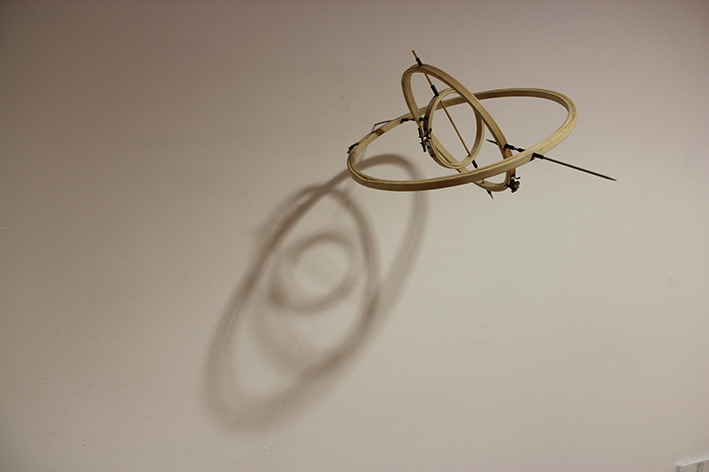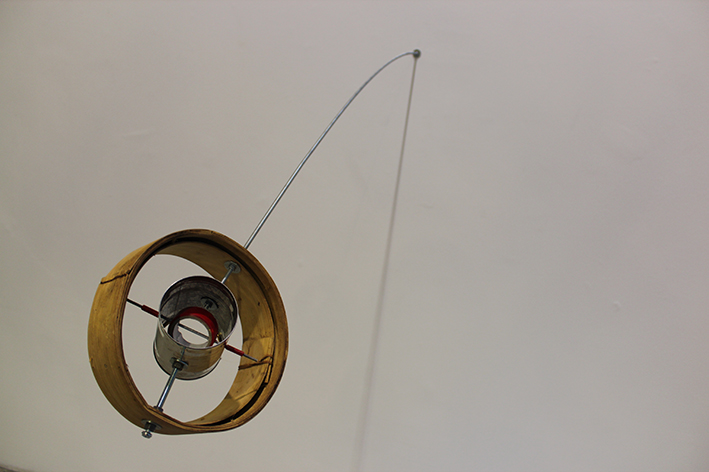Artist Dr Aisling O'Beirn's new exhibition Quaternion Quest at The LAB Gallery in Dublin investigates ways of portraying Irish mathematician William Rowan Hamilton's insights using real objects
Artist Aisling O’Beirn’s new exhibition charts her quest to understand Hamilton’s quaternions through objects, space and … knitting.
In October 1843, Irish mathematician William Rowan Hamilton was walking by the Royal Canal in Dublin when inspiration struck. He took out a knife and etched into the wall of Broom Bridge in Cabra the equation i2 = j2=k2=ijk=-1.
He had described quaternions, a number system that enables calculations of three-dimensional rotations.
That act of hasty note-taking – or mathematical vandalism perhaps? – is considered a milestone of algebra and Hamilton’s quaternions have been used for many things, including more realistic-looking video games and manoeuvring real spacecraft.
Quaternion curiosity
Artist Dr Aisling O’Beirn heard about Hamilton’s moment of revelation several years ago from mathematician friends Dr Áine McManus and Dr Peter Kootsookos.
“They were poring over a map of Dublin looking for Broom Bridge, and they asked if I knew where it was,” she recalls. “When I asked why, they told me the story about Hamilton and tried to explain the equation to me. I was intrigued and I always thought there was a piece of work here to explore the idea of a ‘layperson’ trying to understand this equation.”
The result is Quaternion Quest, O’Beirn’s new exhibition at The LAB Gallery at Dublin City Council’s Arts Office, in which she investigates ways of portraying Hamilton’s insights using real objects.
Bridging space and objects – and knitting
As you walk into the exhibition itself, there’s a feeling of space. Objects are dotted around and a constructed bridge aptly connects the lower and mezzanine level.
Then there’s the knitting, which features prominently.
“I started thinking about this idea of an X, Y and Z axis and the rotation taking place around them,” says O’Beirn. “So I constructed X, Y and Z axes and then it occurred to me would knitting be like a function.”
Out with the knitting needles (three of them in some cases) and on with the exhibition, for which she spoke with people who have wrapped their brains around plenty of equations.

A bridge connects the lower and mezzanine level as part of Dr Aisling O’Beirn’s new exhibition Quaternion Quest at The Lab Gallery in Dublin
Retracing Hamilton’s steps
Hamilton was the Royal Astronomer of Ireland at Dunsink Observatory and president of the Royal Irish Academy when he discovered quaternions – in fact the bridge moment happened as he walked between the two locations.
O’Beirn worked with Dunsink Observatory and traced Hamilton’s steps with another former president of the RIA, Prof Luke Drury, who directs the School of Cosmic Physics at Dublin Institute for Advanced Studies (DIAS). She also spoke with Dr Fiacre Ó Cairbre from Maynooth University.
O’Beirn recorded her discussions with mathematicians, and the resulting video draws together the elements of the exhibition, including Drury expertly explaining concepts using everyday objects, such as a book and a bottle of water.


Two more items from Aisling O’Beirn’s exhibition Quaternion Quest at The Lab Gallery in Dublin
Inspiring curiosity
O’Beirn, who hails from Galway and now lives in Belfast, is an associate lecturer in sculpture with the University of Ulster, and her work ‘is concerned with the politics of space’.
She has an interest in science and has worked with Armagh Observatory on Quantum Questions for Dummies and Some Structures Invisible to the Naked Eye and also separately on topics such as Sputnik and the Higgs boson.
So, what does she hope visitors will get from Quaternion Quest?
“When I make exhibitions I am interested in people asking more questions and being curious – I’d hope that people might to start to look at how things move in space, and hopefully people will find (objects in the exhibition) playful, as well.”
Quaternion Quest is at The LAB Gallery, Foley St, Dublin 1. Admission is free and the exhibition runs until 8 November.
As part of Culture Night, The LAB venue is open this evening and will feature tours, workshops and a special performance by Niamh Shaw of her work To Space.
Women Invent Tomorrow is Silicon Republic’s campaign to champion the role of women in science, technology, engineering and maths. It has been running since March 2013, and is kindly supported by Accenture Ireland, Intel, the Irish Research Council, ESB, Twitter, CoderDojo and Science Foundation Ireland.